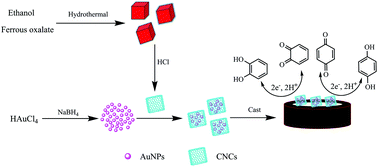Simultaneous electrochemical detection of catechol and hydroquinone based on gold nanoparticles@carbon nanocages modified electrode†
Abstract
In the present study, carbon nanocages (CNCs) decorated with gold nanoparticles (AuNPs) with diameters of 2–5 nm were synthesized by simply mixing their solutions. The sizes of the AuNPs are small enough to diffuse into the inside of the CNCs by electrostatic incorporation and their morphologies were characterized by transmission electron microscopy, X-ray diffraction, energy dispersive spectrometry, Raman spectrometry and ultraviolet visible absorption spectra. The AuNPs@CNCs modified electrode was prepared for simultaneous highly sensitive determination of catechol (CC) and hydroquinone (HQ). This modified electrode demonstrated fantastic eletrochemical catalytic activities towards CC and HQ by cyclic voltammetry and differential pulse voltammetry. The calibration curves showed a linear response between the peak currents and the concentrations of CC and HQ. A wide dynamic detection range of 1.0–250.0 μM and 0.1–200.0 μM with a low detection limits (S/N = 3) of 0.0986 μM and 0.0254 μM can be obtained for CC and HQ respectively. The present method was successfully employed for determination of CC and HQ in a practical sample.


 Please wait while we load your content...
Please wait while we load your content...